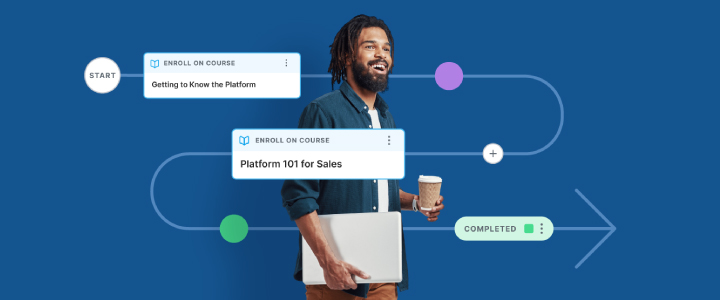
4 min reading time
Learner-Centered Approaches: Why They Matter and How to Implement Them
When gearing up to plan a learning and development program, it’s a good time to look at how your training is delivered and see where you can adopt a more learner-centered approach in your sessions.
Whether you deliver your training face-to-face or through an LMS, taking a learner-centered approach has a dramatic impact on how much of the training information your employees will retain.
What is a learner-centered approach?
A learner-centered approach views learners as active agents. They bring their own knowledge, past experiences, education, and ideas – and this impacts how they take on board new information and learn.
It differs significantly from a traditional instructor-centered approach. Traditional learning approaches were informed by behaviorism, which sees learners as ‘blank slates’ and instructors as experts who must impart all the relevant information. This approach sees learners as respondents to external stimuli.
University lecturer Martha Kennedy defined it as:
“…a classroom dynamic in which the students participate actively while the teacher might take a (seemingly) more passive role. It boils down to group work, one-on-one tutoring in the classroom between student and teacher, student presentations…To learn a skill, students must be directly involved. No teacher can stand there and tell the students how to do something and expect the students to leave the classroom able to do it.”
This is the principle that underpins both Cognitive Learning Theory and Constructivist Learning Theory, and is also featured in Adult Learning Theory.
Why take a learner-centered approach?
Each learning theory has its own school of thought, but one point seems to crop up again and again: the more engaged employees are in the learning process, the more they will retain when they get back to work.
Learner-centered approach activities
Here are some practical ideas for incorporating learner-centered activities into your corporate training:
1. Foster collaboration with group projects
Think of yourself as a coach on the sideline of a sports game. You’re offering advice and encouragement where necessary, rather than a lecturer delivering a monologue to learners.
2. Let learners develop content
Start a forum within your LMS, develop and share blogs or upload podcasts or videos for your learners and let them work individually or in groups to contribute to it. Let them know what topics should be covered and encourage them to research them. Over time, this channel will become a valuable resource for everyone at the organization.
3. Stage presentations
Or, instead of using their research to create different types of media, ask your learners to develop presentations, which can be delivered in-person or via a live webinar (particularly handy for remote teams). Not only does it help your learner learn the topic inside out, they also get a chance to develop another important workplace skill – presenting. Learn more on how to stage a demonstration or product demonstration.
4. Hold a competition
A little healthy competition can really spur motivation in a group. You can even let the group decide what the nature of the competition will be, and what the prize will be – or if it’s just for pride.
5. Hold a debate
Split the group in three and give them a motion. One group argues for the motion, one argues against it, and the final group judges. All groups have to stay fully engaged with the topic until the end, and should come out of the debate thoroughly informed on the issue. Again, this can be in-person or via a live training session held in your LMS.
6. Gamify learning
Games are a great way to add an element of fun to the learning environment. Gamification has been a huge trend in online learning in recent years. Any good LMS will have gamification features such as leaderboards, badges, points, and more that will encourage learner participation.
7. Pose a problem
Learner-centered approaches work best when your employees feel like they’re solving real problems and learning skills they can put to work immediately. As such, you can pose real problems the company is facing and ask your learners to identify creative and innovative solutions. With a mix of different levels of experience and skill sets in each session, you will come up with solutions that are genuinely valuable to the company.
8. Do role-play
This is perfect for Sales and Customer Service training. Divide the learners into pairs and let them take turns in the role of the customer. Again this can be done face-to-face or through Live Learning in your LMS. Letting them step into the shoes of your customers is likely to make them more empathetic when they’re speaking to them.
9. Brainstorm
Twelve heads are better than one. Not all training techniques need to be hi-tech and fancy; just choose a topic you want your learners to know more about and ask them to volunteer what they already know. As a group, the chances are they know a great deal – and you can fill in any gaps as necessary.
10. Do a demo
Whether you’re training on something highly scientific or the ins and outs of new software, showing is often better than telling. Stage a demonstration to show exactly how it works. This can be achieved by uploading a step-by-step video to your LMS.
As well as learning about the topic at hand, learner-centered approaches give your employees ample opportunities to practice the soft skills they need to use every day at work; communication, collaboration, and problem-solving – among others.
It’s an active approach to taking in new materials where learners are given a large degree of autonomy. And it’s ideal for a corporate training environment where individuals are expected to be able to work both independently and in groups.
Do you take a learner-centered approach in your training sessions, or do you prefer a more traditional approach? Are you planning on implementing any of the suggestions we’ve made above? Let us know below in the comments.



